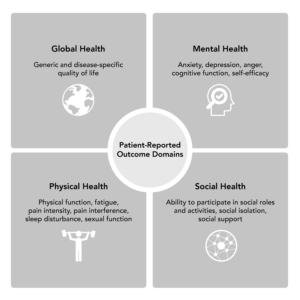Patient-Reported Outcomes — What Are They and How Do They Work?
How do patients choose their doctors?
This is the million-dollar question many healthcare providers ask, and the answer might differ depending on who is being asked. While some patients may base their decision on the provider’s reputation, others may choose based on location, insurance coverage, or online reviews. Yet, there’s one thing that all patients want — high-quality care that addresses their unique needs and concerns.
Healthcare organizations consistently evaluate things like mortality rates, length of stay, readmissions, lab values, or other process measures to gain a valuable perspective on the effectiveness of healthcare interventions. Issues that impact a patient’s quality of life often get overlooked, but to provide better care, healthcare providers need to accurately define what qualifies as a good outcome. For example, patients with hip replacements worry about things like, “Will I be able to take my dog for a walk?” or “Will I be able to play with my grandkids at the park?” They care about symptoms, daily activities, functional status, and mental health. All these things are tricky for healthcare providers to measure, which is where patient-reported outcomes (PRO) come in.
Patient-reported outcomes provide the missing link in defining a good outcome by capturing the quality of life matters that patients care about and which often cause them to seek out treatment in the first place. In other words, by measuring the outcomes that matter most to patients, you can better understand the impact of health conditions on patients’ lives and identify areas where treatment may be needed.
Patient-reported outcomes are often used in the context of chronic conditions such as osteoarthritis, where the aim is to measure changes in pain, function, and quality of life over time. The Knee Injury and Osteoarthritis Outcome Score (KOOS) and Hip Disability and Osteoarthritis Outcome Score (HOOS) are examples of patient-reported outcomes used specifically for assessing joint health in patients with knee or hip osteoarthritis. Incorporating these measures into routine clinical practice helps you provide care that is aligned with the patient’s unique needs and priorities, ultimately leading to better physical and emotional health.
What Are Patient-Reported Outcomes?
Patient-reported outcomes are measures that assess health outcomes from the perspective of the patient in order to evaluate the effectiveness of healthcare interventions and to guide clinical decision-making. With the help of PROs, healthcare providers can measure a wide range of health outcomes such as pain, physical function, quality of life, and symptoms such as depression and anxiety. PRO questions fall into 4 different categories to assess the overall wellbeing in Global, Mental, Physical, and Social Health. These categories ask specific questions to determine the necessity and outcome of healthcare intervention. 
One of the main advantages of patient-reported outcomes is that they provide a patient-centered perspective on health outcomes. By asking patients directly about their experiences, priorities, and goals, you can focus on their needs and preferences, rather than just the disease or condition they have. This way, you can recognize that each of your patients is unique, measure the outcomes that matter most to them, and treat them accordingly.
PROs also play a key role in shared decision-making, which is another important aspect of patient-centered care. This approach involves a collaborative process in which patients and healthcare providers work together to make treatment decisions based on the patient’s values and preferences. Using PROs in conjunction with traditional clinical measures allows you to provide a more comprehensive view of the patient’s health and work together with them to develop a personalized treatment plan that optimizes their health outcomes and quality of life.
Patient-reported outcomes are typically assessed using surveys that patients complete themselves. These surveys may include Likert scales or visual analog scales, where patients rate their experiences on a scale from 0 to 10. The responses are then analyzed to calculate scores for each domain and an overall score for the patient’s health.
KOOS and HOOS Surveys
Patient-reported outcomes are often used in the context of chronic conditions to help healthcare providers identify areas where treatment may be needed, track changes in patients’ health over time, and compare the effectiveness of different treatments.
KOOS and HOOS are PROs used specifically for assessing joint health in patients with knee or hip osteoarthritis. These surveys consist of several domains that are relevant to knee or hip osteoarthritis, such as pain, stiffness, function in daily living, function in sport and recreation, and quality of life.
By using these patient-reported outcomes, you can gain a better understanding of how knee or hip osteoarthritis is affecting your patients’ lives. For example, patients answer questions about their ability to perform daily activities such as walking, climbing stairs, and getting in and out of a car, as well as their ability to participate in more active pursuits. KOOS and HOOS surveys also ask about the level of pain and discomfort the patient is experiencing, as well as their overall quality of life.
The KOOS survey is used as a reliable and valid measure of patient-reported knee health outcomes. It consists of 42 items and is divided into five subscales: pain, symptoms, function in daily living, function in sport and recreation, and knee-related quality of life. Each subscale of the KOOS is scored separately, with a higher score indicating better knee health status. The subscales can also be combined to create an overall score for the patient’s knee health status.
The HOOS questionnaire also includes five subscales that assess pain, symptoms, function in daily living, function in sport and recreation, and hip-related quality of life. The survey covers 40 items that are answered on a 5-point Likert scale. In general, KOOS and HOOS surveys are administered at the initial evaluation as well as at regular intervals throughout the course of treatment to track the patient’s progress over time.
The Knee Injury and Osteoarthritis Outcome Score, Joint Replacement (KOOS, Jr.) and Hip Disability and Osteoarthritis Outcome Score, Joint Replacement (HOOS, Jr.) are shorter versions of the full KOOS and HOOS surveys, designed to be more efficient and less burdensome for patients. KOOS Jr. and HOOS Jr. cover the same domains as the full surveys, but contain fewer questions — KOOS Jr. includes 7 and HOOS Jr. 8 items.
Collecting information directly from the patient helps you get a more patient-centered perspective on the impact of knee or hip osteoarthritis on your patients’ lives. For example, you can track changes in patients’ joint health over time and compare the effectiveness of different treatments. Apart from this, you can better identify patients who are good candidates for joint replacement surgery. For example, if a patient’s KOOS or HOOS score is low, it may suggest that they would benefit from interventions to improve their knee or hip health, including surgery or other treatments.
Use Patient Feedback to Improve Quality Outcomes
Patient-reported outcomes allow you to better understand your patient’s needs and preferences, leading to improved patient satisfaction, treatment adherence, and overall health outcomes. However, capturing PROs can be time-consuming and require additional resources, with results difficult to analyze and interpret, especially if you’re using paper-based systems. In addition, you may need to educate your patients on the importance of completing PRO surveys and ensure that they understand how to do this accurately.
Despite these challenges, capturing patient-reported outcomes is becoming increasingly important in healthcare, and many providers are finding ways to make the process more efficient. SocialClimb’s PRO survey tools help you collect, analyze, and use data to improve patient outcomes. The surveys are customizable, allowing you to choose from a range of standard surveys such as HOOS Jr., KOOS Jr., ASES, or others, or to create your own surveys according to your specific needs. This flexibility helps you find the most appropriate surveys for your patients and focus on the specific health outcomes that are most important to your practice.
In addition to this, SocialClimb’s surveys are easy for patients to complete, with online and mobile-friendly options available, while the results are automatically scored and presented in an easy-to-understand format. This allows you to quickly identify areas where treatment may be needed, track changes in patients’ health over time, and improve patient care with a more personalized and effective approach based on patient-reported outcomes.











